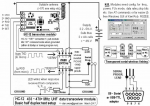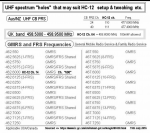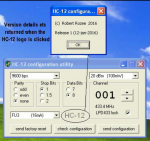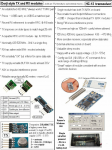Hi,
I have been trying to configure 2 HC12 transceivers using a pgm I have used succesfully before on the 2 HC12s several times. I get "No response" (5 of them) or 5 identical answers containing mostly hex characters (the same every time).
I have had the problem before a long time ago. This time I had the configuring working for a while after having fiddled with power, gnd.,Rx,Tx and Set terminals on the HC12 with a multimeter, but it soon stopped working again - and I dont know what I did to make it work. The last time I just changed the HC12s.
I found on Internet the following method to reset HC12:
(AlbertHall May 25, 2018)
Joined Jun 4, 2014
I have now solved this conundrum. The sequence should be:
Hold SET low.
(delay)
Power up HC-12.
(delay)
Maintain SET low. The HC-12 interface will now be the defaut 9600, 8, n, 1
Send commands to configure the HC-12 as you wish.
Take SET high.
(delay)
The HC-12 will now be using whatever configuration you set.
The HC12s with which I have the problem is soldered in place and I had to disconnect the HC12 and reconnect it at "Power up HC12, but then the the pgm starts all over.
My question is: Is there an authorised way of reseting a HC12 (soldered in place) that has gone haywire or must I consider it lost (2 at the same time)?
One of the HC12s is powered by 3 AAs so overloading the HC12 cannot have happened.
Best regards
torben
I have been trying to configure 2 HC12 transceivers using a pgm I have used succesfully before on the 2 HC12s several times. I get "No response" (5 of them) or 5 identical answers containing mostly hex characters (the same every time).
I have had the problem before a long time ago. This time I had the configuring working for a while after having fiddled with power, gnd.,Rx,Tx and Set terminals on the HC12 with a multimeter, but it soon stopped working again - and I dont know what I did to make it work. The last time I just changed the HC12s.
I found on Internet the following method to reset HC12:
(AlbertHall May 25, 2018)
Joined Jun 4, 2014
I have now solved this conundrum. The sequence should be:
Hold SET low.
(delay)
Power up HC-12.
(delay)
Maintain SET low. The HC-12 interface will now be the defaut 9600, 8, n, 1
Send commands to configure the HC-12 as you wish.
Take SET high.
(delay)
The HC-12 will now be using whatever configuration you set.
The HC12s with which I have the problem is soldered in place and I had to disconnect the HC12 and reconnect it at "Power up HC12, but then the the pgm starts all over.
My question is: Is there an authorised way of reseting a HC12 (soldered in place) that has gone haywire or must I consider it lost (2 at the same time)?
One of the HC12s is powered by 3 AAs so overloading the HC12 cannot have happened.
Best regards
torben





